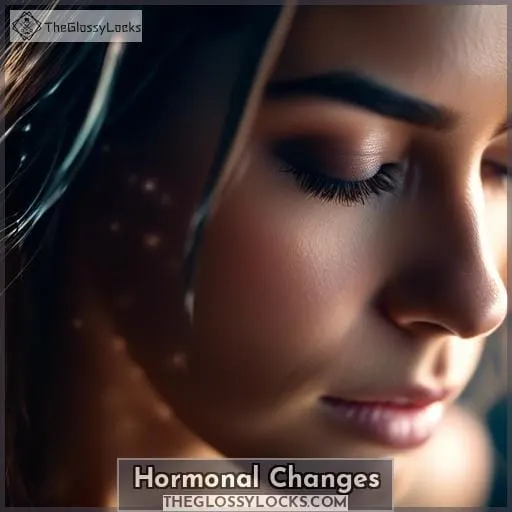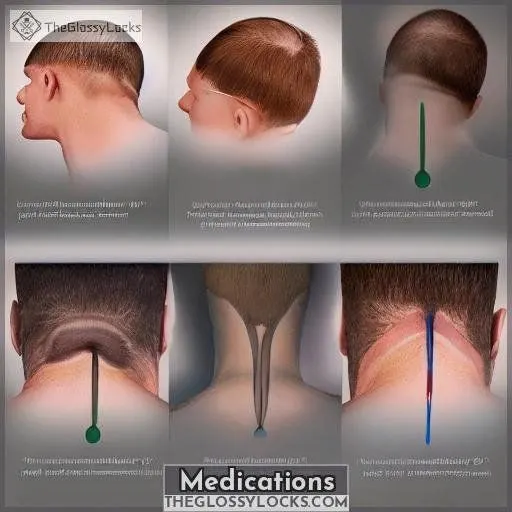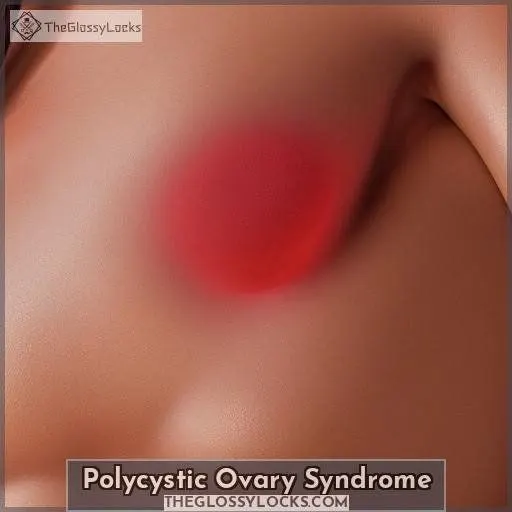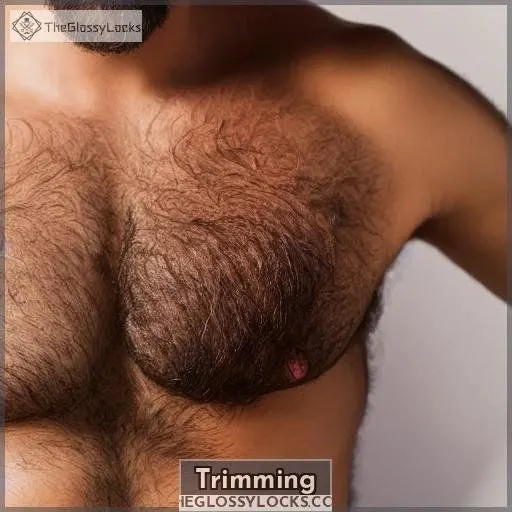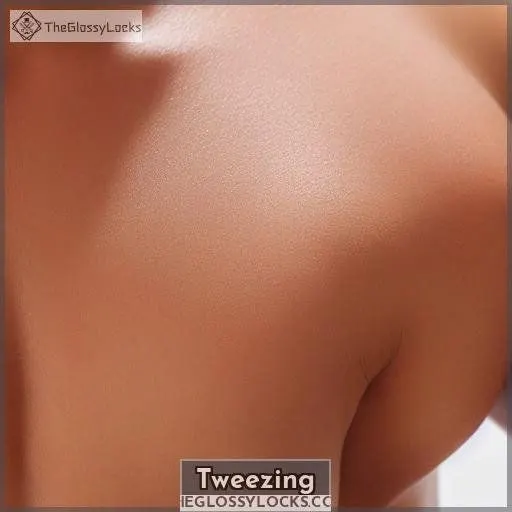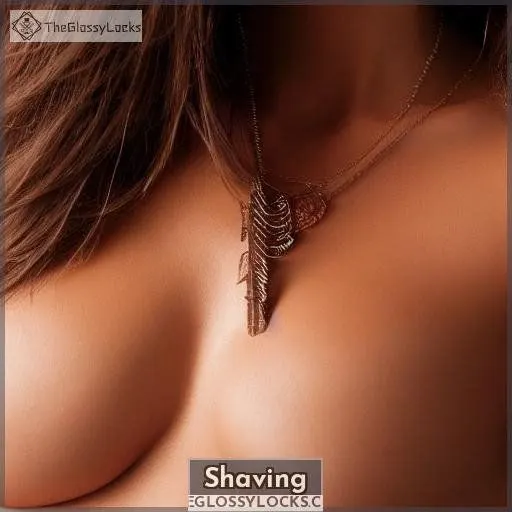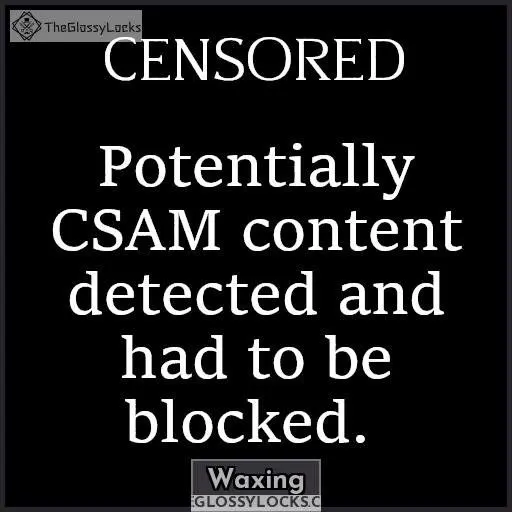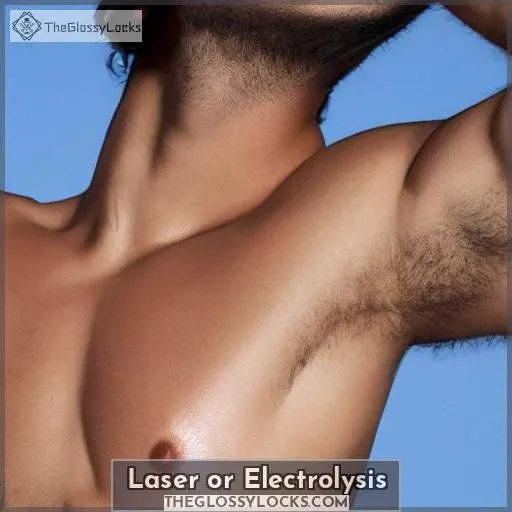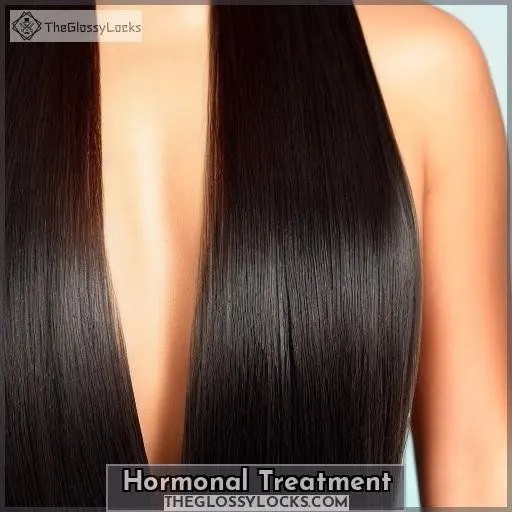This site is supported by our readers. We may earn a commission, at no cost to you, if you purchase through links.
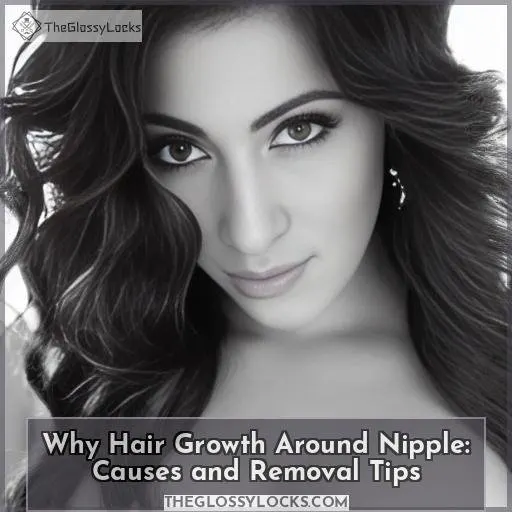
Medications like corticosteroids and anabolic steroids can induce hirsutism, a condition characterized by excessive hair growth. Polycystic Ovary Syndrome (PCOS) and Cushing’s Syndrome are hormonal disorders that can lead to hair growth around the nipples.
For hair removal, you can consider trimming for convenience, tweezing for precision, shaving for ease, waxing for root removal, or laser/electrolysis for permanence. If your hair growth concerns persist or intensifies, consulting a healthcare professional can help identify the underlying cause and determine the most appropriate treatment.
Table Of Contents
Key Takeaways
- Hormonal changes, such as those during puberty, pregnancy, menopause, and in the 20s and 30s, can significantly impact hair growth around the nipples.
- Certain medications, including corticosteroids, anabolic steroids, selective estrogen receptor modulators (SERMs), hair growth medications like minoxidil, immunosuppressants like cyclosporine, interferon, and seizure medications like phenytoin, have been linked to hirsutism, a condition that causes excess hair to grow on parts of the body, including the nipple area.
- Polycystic ovary syndrome (PCOS) is a common hormonal disorder that can lead to infertility, hirsutism, and excessive hair growth, including on the breasts and around the nipples.
- Hormonal treatment, such as birth control pills or single hormone treatments, can help regulate hormonal fluctuations, potentially reducing the growth of nipple hair.
Why Hair Growth Around Nipple?
Why hair growth around nipple? Hormonal changes or medical conditions can cause increased hair growth in that area. Some nipple hair is normal, but excessive growth may indicate an underlying health issue.
Hormonal Changes
Hormonal changes can significantly impact hair growth around the nipples. These changes can occur during various stages of life, such as puberty, pregnancy, menopause, and even in the 20s and 30s. Hormonal imbalances, like those caused by an overproduction of male hormones or an increase in androgens like testosterone, can lead to hirsutism, a condition characterized by excessive hair growth in women.
Birth control pills or single hormone treatments can help regulate hormonal fluctuations, potentially reducing the growth of nipple hair. Additionally, hormonal changes during pregnancy can cause hair growth around the nipples to seem longer and darker. Menopause, a natural hormonal shift in women, can also contribute to changes in nipple hair growth.
It is essential to consult a doctor if you suspect hormonal imbalances or if you experience excessive hair growth accompanied by other symptoms. Your doctor can perform blood tests to check hormone levels and rule out underlying conditions like polycystic ovary syndrome (PCOS) or Cushing’s syndrome, which can cause hirsutism.
Medications
Medications can also cause hair growth around the nipple.
Certain medications, such as corticosteroids, anabolic steroids, selective estrogen receptor modulators (SERMs), hair growth medications like minoxidil, immunosuppressants like cyclosporine, interferon, and seizure medications like phenytoin, have been linked to hirsutism, a condition that causes excess hair to grow on parts of the body, including the nipple area.
If you suspect that your medication is causing nipple hair growth, it’s essential to consult your doctor before stopping the medication abruptly. They can help determine if the medication is the root cause and suggest alternative treatments or adjustments to your medication regimen.
Polycystic Ovary Syndrome
Polycystic ovary syndrome (PCOS) is a common hormonal disorder that affects women of reproductive age.
It’s characterized by irregular periods, high levels of androgens (male hormones), and the presence of small cysts on the ovaries.
PCOS can lead to infertility due to the irregular ovulation and menstruation, which is a result of the hormonal imbalance.
The condition can also cause hirsutism, or excessive hair growth, in various parts of the body, including the nipples.
PCOS is often associated with insulin resistance, which can increase the risk of developing type 2 diabetes if left untreated.
Treatment for PCOS may include hormonal medications, such as birth control pills, and lifestyle changes, such as weight loss and exercise.
Cushing’s Syndrome
Cushing’s syndrome is a rare hormonal disorder caused by high levels of cortisol, a hormone produced by the adrenal glands, over an extended period.
It’s most commonly seen in adults aged 20 to 50 years.
It can be caused by a tumor in the pituitary gland, adrenal glands, or by taking steroid medications for an extended time.
The condition can lead to excessive hair growth, including on the breasts and around the nipples.
If you suspect you have Cushing’s syndrome, it’s essential to consult a healthcare professional for proper diagnosis and treatment.
Trimming
Trimming is a simple and effective way to manage unwanted hair growth around the nipples.
This non-invasive method involves using small scissors or manicure scissors to cut the hair close to the skin.
It’s essential to be careful not to cut the skin while trimming, as the nipple area is sensitive.
This method is less time-consuming and less painful than waxing or electrolysis.
However, it requires regular upkeep as the hair will continue to grow.
Tweezing
Tweezing is another effective method for removing nipple hair, but it requires patience and precision.
- Pain management: Tweezing can be uncomfortable, so consider applying a numbing cream beforehand.
- Skin irritation: To minimize irritation, use a clean pair of tweezers and avoid pulling out the hair from the root.
- Regrowth time: Hair may grow back faster after tweezing, so consider combining this method with others for long-term hair removal.
- Ingrown hairs: Be careful not to break the skin while tweezing, as this can lead to ingrown hairs.
Shaving
Shaving is a common method for removing hair, but it might not be the best option for underarm hair.
Shaving can lead to razor burn, skin irritation, ingrown hairs, and razor bumps, which can be uncomfortable and unsightly.
While shaving is quick and easy, it’s not recommended for sensitive skin around the underarms.
Instead, consider tweezing, waxing, sugaring, or laser hair removal for more effective and long-lasting results.
If you do decide to shave, make sure to use a sharp razor, shave in the direction of hair growth, and apply a soothing aftershave or lotion to minimize irritation.
Waxing
Shifting gears from shaving, let’s dive into waxing. This method pulls hair from the root, promising smoother skin for longer.
- Types of wax: Choose between hard and soft wax. Hard wax is gentler on sensitive areas.
- Pain management: A deep breath and a quick pull can make it bearable. Think of it as ripping off a Band-Aid.
- Skin preparation: Exfoliate beforehand to lift hairs and reduce the chance of ingrown hairs.
- Post-wax care: Soothe your skin with aloe or an anti-inflammatory cream to calm redness.
- Ingrown hairs: Regular exfoliation post-wax can keep these pesky buggers at bay.
Laser or Electrolysis
As we delve deeper into the realm of hair removal, let’s explore the two most popular permanent methods: laser hair removal and electrolysis. These methods are designed to enhance your experience and provide long-lasting results.
Laser hair removal uses light energy to target and destroy hair follicles. It’s not merely a one-time treatment; it’s a series of sessions tailored to your hair growth cycle. The advantages are numerous: it’s precise, fast, and can treat large areas at once. However, it may not be suitable for everyone, especially those with darker skin tones or certain medications.
Electrolysis, on the other hand, uses an electric current to destroy hair follicles. It’s a more meticulous process, as each hair follicle is treated individually. The advantages include its versatility – it can be used on any skin type and color, and it’s effective on all hair types. However, it can be more time-consuming and may require multiple sessions.
Both methods have their complexities and advantages, so it’s advisable to consult a professional before deciding which one is best for you. Remember, the world of hair removal is ever-evolving, and there’s always more to discover.
Hormonal Treatment
If hormonal imbalances are the root cause of your excessive nipple hair, hormonal treatment may be the solution.
Birth control pills or single hormone treatments can help regulate hormone levels, potentially reducing hair growth.
Hormone replacement therapy can also be beneficial for those experiencing hormonal changes during menopause.
Anti-androgen medications like spironolactone can be prescribed to block the production of male hormones, such as testosterone, which can contribute to hair growth.
Consult with your healthcare provider to determine the best course of treatment for your specific situation.
Frequently Asked Questions (FAQs)
Is nipple hair growth linked to breast cancer?
No, nipple hair growth isn’t directly linked to breast cancer. It’s usually caused by hormonal changes or underlying conditions like PCOS. But see your doctor if you notice any unusual breast changes along with excess hair growth.
Can stress or anxiety cause nipple hair growth?
You’re right to wonder – stress can impact hormone levels, leading to bodily changes like excess nipple hair growth. While anxiety alone isn’t a direct cause, managing your stress through healthy outlets may help regulate hormones.
Is it safe to remove nipple hair during pregnancy?
If you’re expecting, it’s best to avoid removing nipple hair. Hormonal changes can make your skin more sensitive, leading to irritation or infection. Wait until after birth to remove unwanted hair.
Can nipple hair growth be a sign of thyroid issues?
Yes, nipple hair growth can potentially indicate an underlying thyroid issue. An overactive or underactive thyroid can disrupt hormone levels, leading to abnormal hair patterns in various areas, including around the nipples. Consulting a doctor is advisable if you notice excessive nipple hair growth.
Are there any home remedies to reduce nipple hair growth?
Yes, mixing turmeric with gram flour and sesame oil creates a paste that, when applied weekly, can help tame that pesky nipple hair. It’s like giving your nipples a natural, gentle hug.
Conclusion
Like an intricate tapestry, hair growth around nipples weaves together various factors. While trimming, tweezing, or waxing offer temporary relief, addressing underlying causes like hormonal imbalances or medications through professional guidance provides a more sustainable solution. Ultimately, understanding your body’s unique symphony empowers you to harmonize with its rhythms, unveiling a path to embrace your natural beauty with confidence.

